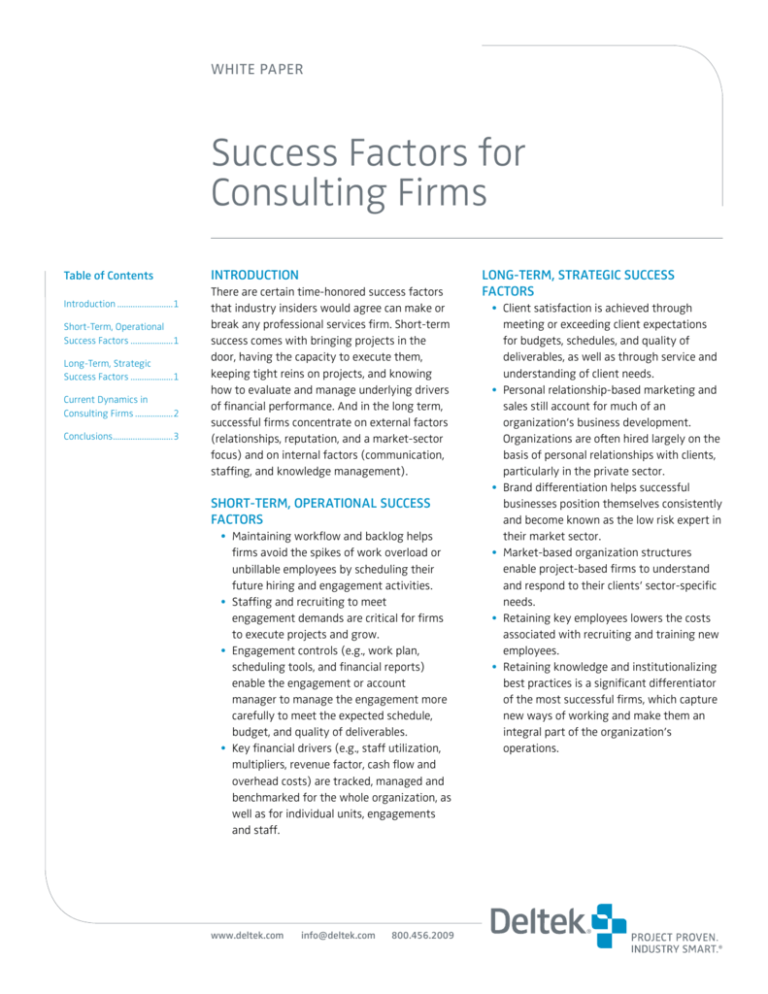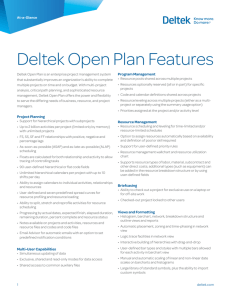
WHITE PAPER
Success Factors for
Consulting Firms
Table of Contents
Introduction..........................1
Short-Term, Operational
Success Factors....................1
Long-Term, Strategic
Success Factors....................1
Current Dynamics in
Consulting Firms..................2
Conclusions............................3
Introduction
There are certain time-honored success factors
that industry insiders would agree can make or
break any professional services firm. Short-term
success comes with bringing projects in the
door, having the capacity to execute them,
keeping tight reins on projects, and knowing
how to evaluate and manage underlying drivers
of financial performance. And in the long term,
successful firms concentrate on external factors
(relationships, reputation, and a market-sector
focus) and on internal factors (communication,
staffing, and knowledge management).
Short-Term, Operational Success
Factors
• Maintaining workflow and backlog helps
firms avoid the spikes of work overload or
unbillable employees by scheduling their
future hiring and engagement activities.
• Staffing and recruiting to meet
engagement demands are critical for firms
to execute projects and grow.
• Engagement controls (e.g., work plan,
scheduling tools, and financial reports)
enable the engagement or account
manager to manage the engagement more
carefully to meet the expected schedule,
budget, and quality of deliverables.
• Key financial drivers (e.g., staff utilization,
multipliers, revenue factor, cash flow and
overhead costs) are tracked, managed and
benchmarked for the whole organization, as
well as for individual units, engagements
and staff.
www.deltek.com
info@deltek.com
800.456.2009
Long-Term, Strategic Success
Factors
• Client satisfaction is achieved through
meeting or exceeding client expectations
for budgets, schedules, and quality of
deliverables, as well as through service and
understanding of client needs.
• Personal relationship-based marketing and
sales still account for much of an
organization’s business development.
Organizations are often hired largely on the
basis of personal relationships with clients,
particularly in the private sector.
• Brand differentiation helps successful
businesses position themselves consistently
and become known as the low risk expert in
their market sector.
• Market-based organization structures
enable project-based firms to understand
and respond to their clients’ sector-specific
needs.
• Retaining key employees lowers the costs
associated with recruiting and training new
employees.
• Retaining knowledge and institutionalizing
best practices is a significant differentiator
of the most successful firms, which capture
new ways of working and make them an
integral part of the organization’s
operations.
Current Externalities in Consulting Firms
Overloaded management and staff.
Most professional services industries are undergoing rapid
change in today’s economy and fast-paced project
environment. Following are some of the current internal and
external dynamics:
Support functions often crumble under the weight of increased
workload, especially in a down economy where people have to
do more with less. When these groups struggle — e.g., failing
to create and distribute timely and informative reports or
letting marketing efforts slide — a “ripple effect” occurs
throughout the organization. Projects suffer, client
relationships are damaged, cash flow problems arise, and so
on.
Stagnant market environment challenging firms to
reduce costs.
Due to the current economic climate, firms are challenged more
than ever to keep tight control on costs, maintain/increase
revenues and show profits in order to stay competitive. Many
professional services firms, from management consulting
organizations to architectural and engineering firms are
struggling to attain and maintain clients while their revenues
are declining. Forward thinking firms that adopt Resource
Optimization and Planning are realizing a significant
advantage over their competitors. Through PSA, they are using
this opportunity to focus on their business structure,
relationships with clients, and processes of winning, producing
and delivering work.
Reduction or elimination of administrative support
staff.
In an effort to drive down overhead costs, many organizations
have greatly reduced their levels of administrative support.
Senior and billable staff are taking more responsibility for their
own word processing and communication tools. Easy-to-learn
automated processes and self-service opportunities for all
employees, particularly in accounting and HR, reduce the
workload and increase support staff productivity.
Industry consolidation and spin-offs.
Hope and fear surrounding the impact of the
internet and e-commerce.
Just as professional services firms were early adopters of the
fax machine for sharing drawings and correspondence, so they
enjoyed many benefits from the arrival of public networks,
e-mail, and the web. Now, however, with the advent of project
portals, public collaboration zones, and rudimentary
e-commerce, the Internet has begun to change the very fabric
of many professional services industries. Organizations watch
the changing landscape with high hopes for improved
productivity and opportunity, mingled with fears for how the
traditional relationships in their projects may change and
perhaps marginalize their own role.
Chronic understaffing, shortage of key
professionals, and turnover.
Staffing and recruiting can be both a short and long-term
limitation on an organization’s ability to execute projects and
grow. Effective, organized recruiting is critical if a firm is to
maintain or increase its capacity to take on work. Retaining the
knowledge accumulated by key personnel and using it to train
new employees are of the utmost importance in a
high-turnover environment.
2
WHITE PAPER: Success Factors for Consulting Firms
At the same time, through mergers, acquisitions, and
divestitures, many professional services industries are
becoming more segregated between large, consolidated
organizations and small, niche firms. Organizations that merge
with or acquire another organization wrestle with how to
integrate technical and business processes, as well as how to
pool all employees’ collective knowledge.
Increasingly sophisticated and/or demanding
clients.
Accurate or not, many clients believe that IT advances increase
their opportunity for low-effort awareness of, and participation
in, their projects. Clients of professional services firms generally
perceive superior communication and responsiveness as a
critical quality in their consultants. Some clients demand
project Websites. Overall, clients have reduced their tolerance
for inefficiency.
Sole-sourcing and/or reduction in the number of
suppliers.
Clients are also developing closer relationships with fewer
consultants. It is increasingly difficult for firms to survive
simply by responding to public requests for proposal. Instead,
intimate client relationships and aggressive positioning are
how project-based businesses get on their clients’
most-favored-consultants list.
The race to keep pace in technology with
competitors.
The issue of technology has entered the boardroom. Top
executives are increasingly aware of technology as a basic
requirement for doing business, as well as a market
differentiator and competitive advantage. They worry about
the costs of falling behind the curve.
3
WHITE PAPER: Success Factors for Consulting Firms
Conclusions
Today’s challenging business climate highlights the absolute
necessity of accurate and up to date insight into their business
data. Those firms that invested in tools to manage their
engagement lifecycle in the late 1990s are the same firms that
are positioned for growth, even in the current economic
climate. Firms that embrace the efficiencies and streamlined
business processes are the ones with a significant competitive
advantage against their competitors. The forward thinking
leaders among these companies will understand that a better
time may never come to make a significant investment these
tools. The firms that succeed will be those that enjoy strong
support from the CEO, and can bring all factions of their
management to the table to make a commitment to this
common goal of integrating business and knowledge
management.
Contact
Deltek
www.deltek.com
info@deltek.com
800.456.2009
Deltek (NASDAQ: PROJ) is the leading provider of enterprise applications software designed specifically for
project-focused businesses. For more than two decades, our software applications have enabled organizations to
automate mission-critical business processes around the engagement, execution and delivery of projects. More
than 12,000 customers worldwide rely on Deltek to measure business results, optimize performance, streamline
operations and win new business.
Deltek • 13880 Dulles Corner Lane, Herndon, VA 20171
US & Canada: 800.456.2009 or 703.734.8606 UK +44 (0) 20 7518-5010
© 2008 Deltek, Inc. All rights reserved. All referenced trademarks are the property of their respective owners.










